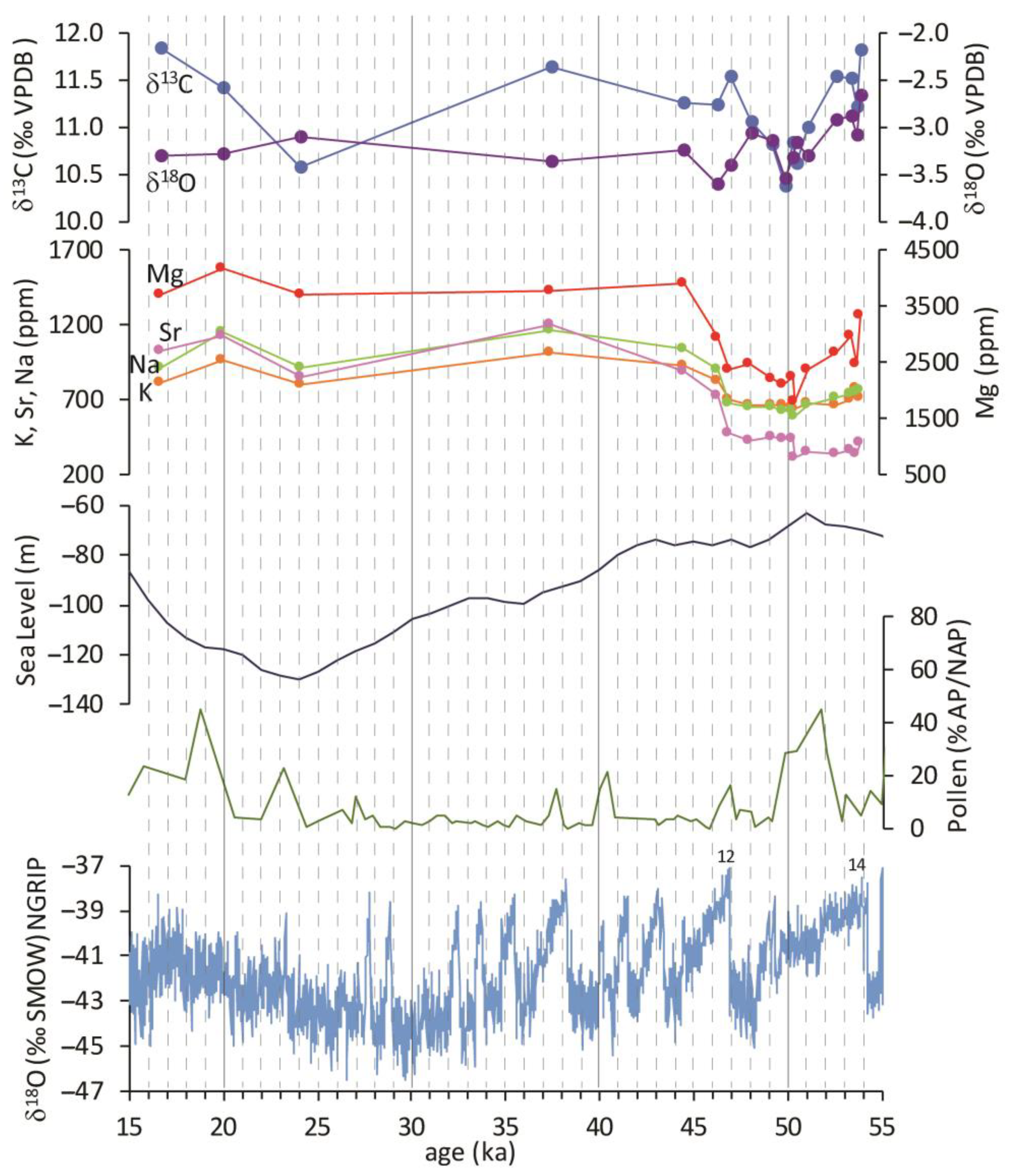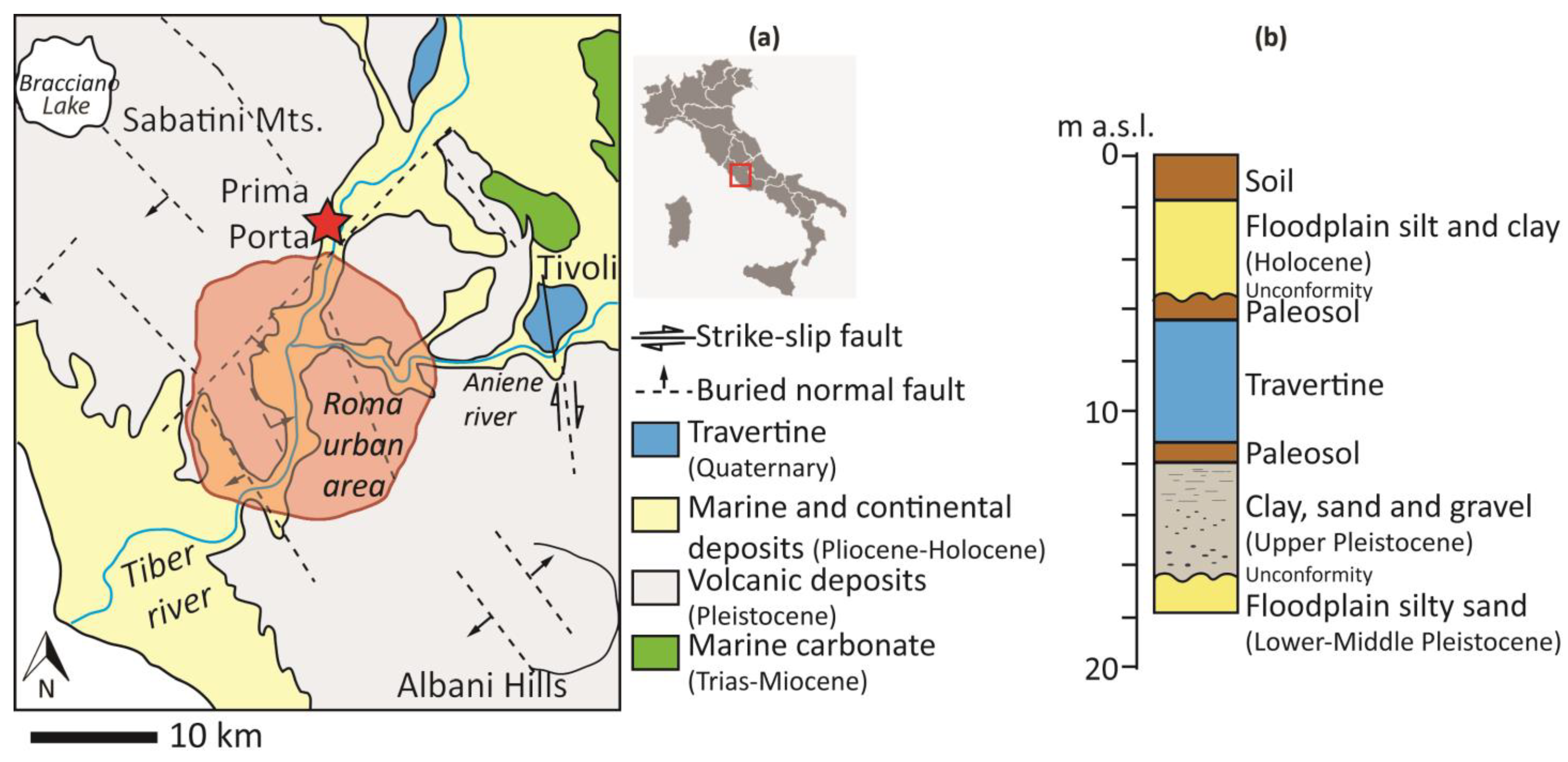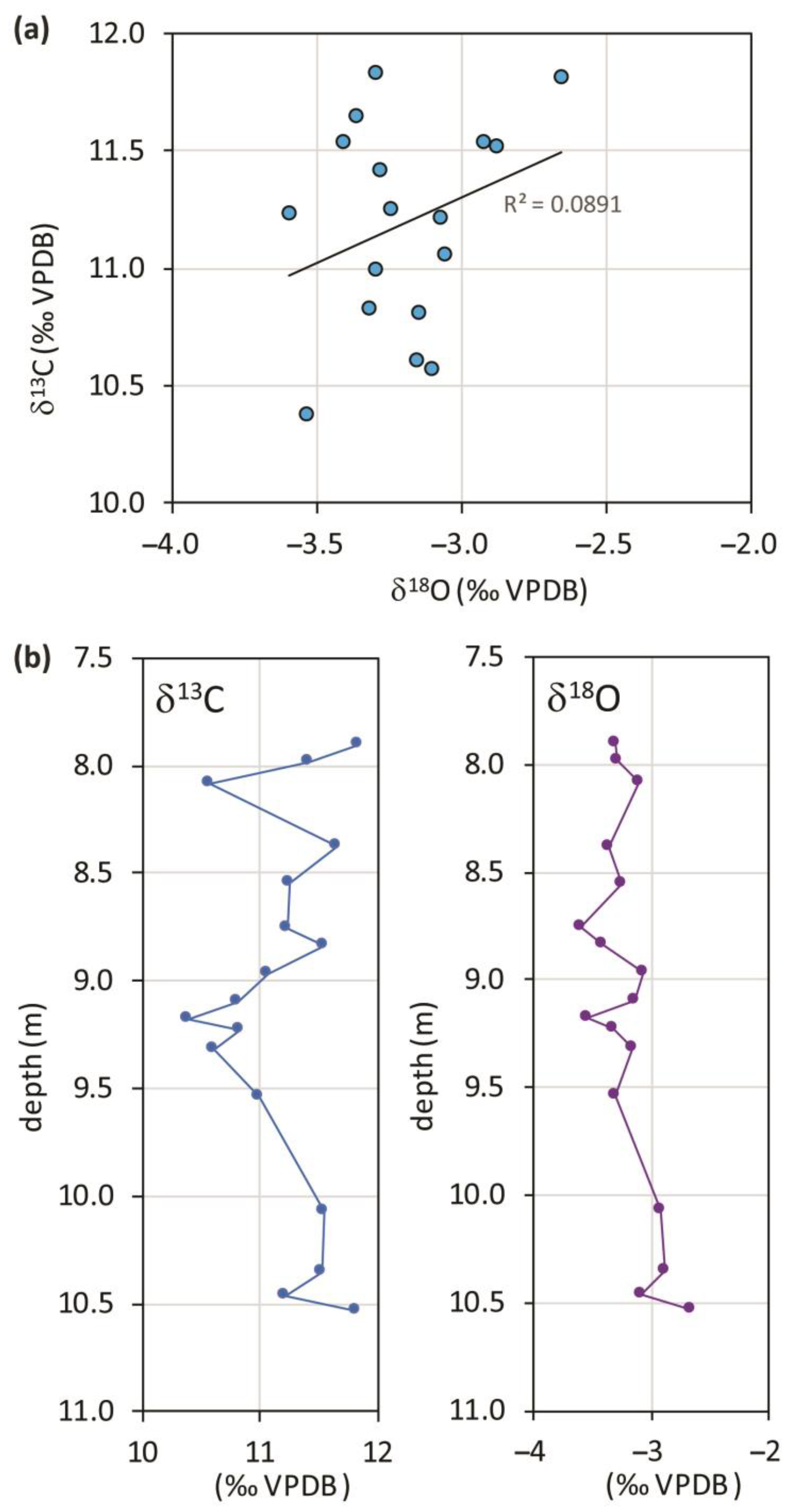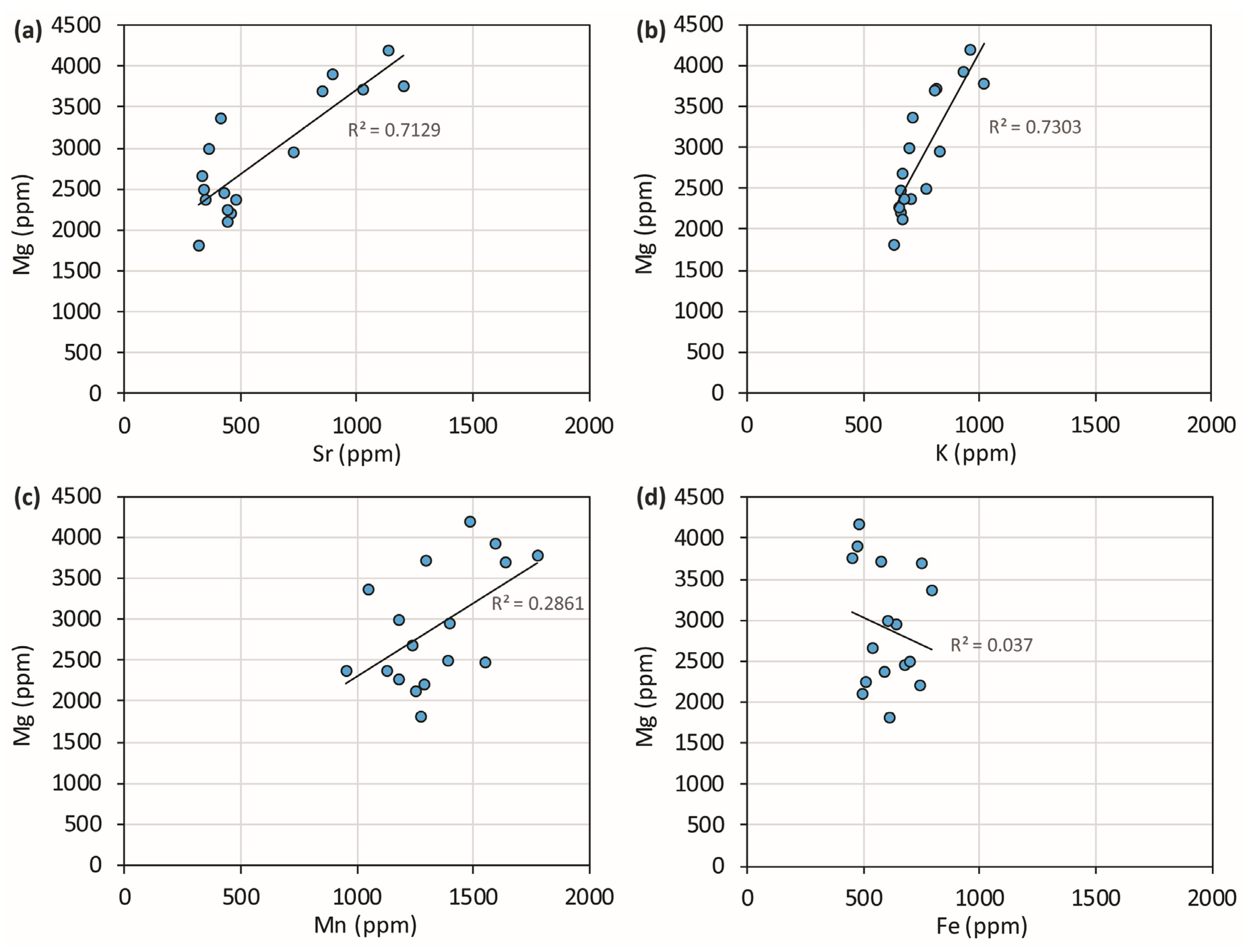Geochemical Stratigraphy of the Prima Porta Travertine Deposit (Roma, Italy)
Abstract
:1. Introduction
2. Geology of the Area
Hydrogeology Features
3. The Previous Studies
4. Sampling and Analytical Method
5. Results
6. Discussion
6.1. PP Travertine Chrono-Stratigraphy

6.2. Climate Evolution in PP Travertine Records
7. Conclusions
Author Contributions
Funding
Data Availability Statement
Acknowledgments
Conflicts of Interest
Appendix A
| RF power | 1.3 kW |
| Gas | Ar 99.999% |
| Plasma Ar flux | 16.5 L min−1 |
| Auxiliary Ar flux | 1.5 L min−1 |
| Nebulizer Ar flux | 0.70 L min−1 |
| Sample aspiration rate | 1 mL min−1 |
| reading | 30 s |
| number of replicates | 3 |
| λ [nm] | LOD * [mg kg−1] | |
|---|---|---|
| Na | 589.592 | 2 |
| K | 766.490 | 4 |
| Ca | 396.847 | 0.06 |
| Mg | 279.553 | 0.04 |
| Fe | 259.940 | 0.8 |
| Mn | 257.610 | 0.08 |
| Sr | 407.771 | 0.05 |
References
- Giustini, F.; Brilli, M.; Mancini, M. Geochemical study of travertines along middle-lower Tiber valley (central Italy): Genesis, palaeo-environmental and tectonic implications. Int. J. Earth Sci. 2018, 107, 1321–1342. [Google Scholar] [CrossRef]
- Giustini, F.; Brilli, M.; Di Salvo, C.; Mancini, M.; Voltaggio, M. Multidisciplinary characterization of the buried travertine body of Prima Porta (Central Italy). Quat. Int. 2020, 568, 65–78. [Google Scholar] [CrossRef]
- Minissale, A.; Kerrick, D.M.; Magro, G.; Murrell, M.T.; Paladini, M.; Rihs, S.; Sturchio, N.C.; Tassi, F.; Vaselli, O. Geochemistry of Quaternary travertines in the region north of Rome (Italy): Structural, hydrologic and paleoclimatic implications. Earth Planet. Sci. Lett. 2002, 203, 709–728. [Google Scholar] [CrossRef]
- Mancini, M.; Girotti, O.; Cavinato, G.P. Il Pliocene e il Quaternario della Media Valle del Tevere (Appennino Centrale). Geol. Rom. 2004, 37, 175–236. [Google Scholar]
- Manfra, L.; Masi, U.; Turi, B. La composizione isotopica dei travertini del Lazio. Geol. Rom. 1976, 15, 127–174. [Google Scholar]
- Faccenna, C.; Soligo, M.; Billi, A.; De Filippis, L.; Funiciello, R.; Rossetti, C.; Tuccinei, P. Late Pleistocene depositional cycles of the lapis Tiburtinus travertine (Tivoli, Central Italy): Possible influence of climate and fault activity. Glob. Planet. Chang. 2008, 63, 299–308. [Google Scholar] [CrossRef]
- De Filippis, L.; Faccenna, C.; Billi, A.; Anzalone, E.; Brilli, M.; Özkul, M.; Soligo, M.; Tuccimei, P.; Villa, I.M. Growth of fissure ridge travertines from geothermal springs of Denizli basin, western Turkey. Geol. Soc. Am. Bull. 2012, 124, 1629–1645. [Google Scholar] [CrossRef] [Green Version]
- Veizer, J. Chapter 8. Trace elements and isotopes in sedimentary carbonate. In Carbonates: Mineralogy and Chemistry; Reeder, R., Ed.; De Gruyter: Berlin, Germany; Boston, MA, USA, 1983; pp. 265–300. [Google Scholar]
- McDermott, F. Palaeo-climate reconstruction from stable isotope variations in speleothems: A review. Quat. Sci. Rev. 2004, 23, 901–918. [Google Scholar] [CrossRef]
- Leng, M.J.; Marshall, J.D. Palaeoclimate interpretation of stable isotope data from lake sediment archives. Quat. Sci. Rev. 2004, 23, 811–831. [Google Scholar] [CrossRef] [Green Version]
- Andrews, J.E. Palaeoclimatic records from stable isotopes in riverine tufas: Synthesis and review. Earth Sci. Rev. 2006, 75, 85–104. [Google Scholar] [CrossRef]
- Kampman, N.; Burnside, N.M.; Shipton, Z.K.; Chapman, H.J.; Nicholl, J.A.; Ellam, R.M.; Bickle, M.J. Pulses of carbon dioxide emissions from intracrustal faults following climatic warming. Nat. Geosci. 2012, 5, 352–358. [Google Scholar] [CrossRef]
- Boccaletti, M.; Ciaranfi, N.; Cosentino, D.; Deiana, G.; Gelati, R.; Lentini, F.; Massari, F.; Moratti, G.; Pescatore, T.; Ricci Lucchi, F.; et al. Palinspastic Restoration and Paleogeographic Reconstruction of the Peri-Tyrrhenian Area during the Neogene. Palaeogeogr. Palaeoclimatol. Palaeoecol. 1990, 77, 41–50. [Google Scholar] [CrossRef]
- Funiciello, R.; Locardi, E.; Parotto, M. Lineamenti geologici dell'area sabatina orientale. Boll. Soc. Geol. Ital. 1976, 83, 831–849. [Google Scholar]
- Barchi, M.; Minelli, G.; Pialli, G. The CROP 03 profile: A synthesis of results on deep structures of the Northern Apennines. Mem. Soc. Geol. Ital. 1998, 52, 383–400. [Google Scholar]
- Jolivet, L.; Faccenna, C.; Goffé, B.; Mattei, M.; Rossetti, F.; Brunet, C.; Storti, F.; Funiciello, R.; Cadet, J.P.; D’Agostino, N.; et al. Midcrustal shear zones in postorogenic extension: Example from the northern Tyrrhenian Sea. J. Geophys. Res. 1998, 103, 12123–12160. [Google Scholar] [CrossRef]
- Chiodini, G.; Cardellini, C.; Amato, A.; Boschi, E.; Caliro, S.; Frondini, F.; Ventura, G. Carbon dioxide Earth degassing and seismogenesis in central and southern Italy. Geophys. Res. Lett. 2004, 31, L07615. [Google Scholar] [CrossRef]
- Acocella, V.; Funiciello, R. Transverse Systems along the Extensional Tyrrhenian Margin of Central Italy and Their Influence on Volcanism. Tectonics 2006, 25, TC2003. [Google Scholar] [CrossRef]
- Billi, A.; Tiberti, M.M.; Cavinato, G.P.; Cosentino, D.; Di Luzio, E.; Keller, J.V.A.; Kluth, C.; Orlando, L.; Parotto, M.; Praturlon, A.; et al. First results from the CROP-11 deep seismic profile, central Apennines, Italy: Evidence of mid-crustal folding. J. Geol. Soc. Lond. 2006, 163, 583–586. [Google Scholar] [CrossRef] [Green Version]
- Mancini, M.; D’Anastasio, E.; Barbieri, M.; De Martini, P.M. Geomorphological, paleontological and 87Sr/86Sr isotope analyses of Early Pleistocene paleoshorelines to define the uplift of Central Apennines (Italy). Quat. Res. 2007, 67, 487–501. [Google Scholar] [CrossRef]
- Funiciello, R.; Giuliani, R.; Marra, F.; Salvi, S. The influence of volcanism and tectonics on Plio-Quaternary regional landforms in the Southeastern Sabatinian area (Central Italy). Mem. Descr. Carta Geol. d’It. 1994, 49, 323–332. [Google Scholar]
- Marra, F.; Rosa, C.; De Rita, D.; Funiciello, R. Stratigraphic and tectonic features of the Middle Pleistocene sedimentary and volcanic deposits in the area of Rome (Italy). Quat. Int. 1998, 47, 51–63. [Google Scholar] [CrossRef]
- Giordano, G.; Esposito, A.; De Rita, D.; Fabbri, M.; Mazzini, I.; Trigari, A.; Rosa, C.; Funiciello, R. The sedimentation along the Roman coast between Middle and Upper Pleistocene: The interplay of eustatism, tectonics and volcanism. New data and review. Il Quat. 2003, 16, 121–129. [Google Scholar]
- Girotti, O.; Mancini, M. Plio-Pleistocene stratigraphy and relations between marine and non-marine successions in the Middle Valley of the Tiber River. Il Quat. 2003, 16, 89–106. [Google Scholar]
- Marra, F.; Florindo, F. The subsurface geology of Rome: Sedimentary processes, sea-level changes and astronomical forcing. Earth Sci. Rev. 2014, 136, 1–20. [Google Scholar] [CrossRef]
- Milli, S. Depositional setting and high-frequency sequence stratigraphy of the Middle-Upper Pleistocene to Holocene deposits of the Roman Basin. Geol. Romana 1997, 33, 99–136. [Google Scholar]
- Funiciello, R.; Giuliani, R.; Marra, F.; Salvi, S. Superfici strutturali plio-quaternarie al margine sud-orientale del Distretto Vulcanico Sabatino. Studi Geol. Camerti. Spec. CROP 1991, 11, 301–304. [Google Scholar]
- De Rita, D.; Funiciello, R.; Parotto, M. Geological Map of the Colli Albani Volcanic Complex, 1:50,000 Scale; SELCA: Florence, Italy, 1988. [Google Scholar]
- De Rita, D.; Faccenna, C.; Funiciello, R.; Rosa, C. Structural and geological evolution of the Colli Albani volcanic district. In The Volcano of the Alban Hills; Trigila, R., Ed.; Tipografia SGS: Rome, Italy, 1995; pp. 33–71. [Google Scholar]
- Barberi, F.; Buonasorte, G.; Cioni, R.; Fiordelisi, A.; Foresi, L.; Iaccarino, S.; Laurenzi, M.A.; Sbrana, A.; Vernia, A.; Villa, I.M. Plio–Pleistocene geological evolution of the geothermal area of Tuscany and Latium. Mem. Descr. Carta Geol. It. 1994, 49, 77–135. [Google Scholar]
- Karner, D.B.; Marra, F.; Renne, P.R. The history of the Monti Sabatini and Alban Hills volcanoes: Groundwork for assessing volcani-tecnonic hazards for Rome. J. Volcanol. Geotherm. Res. 2001, 107, 185–219. [Google Scholar] [CrossRef]
- Alfonsi, L.; Funiciello, R.; Mattei, M.; Girotti, O.; Maiorani, A.; Preite Martinez, M.; Trudu, C.; Turi, B. Structural and geochemical features of the Sabina strike-slip fault (Central Apennines). Boll. Soc. Geol. Ital. 1991, 110, 217–230. [Google Scholar]
- Faccenna, C. Structural and hydrogeological features of Pleistocene shear zones in the area of Rome (Central Italy). Ann. Geofis. 1994, 37, 121–133. [Google Scholar] [CrossRef]
- Faccenna, C.; Funiciello, R.; Mattei, M. Late Pleistocene N-S shear zones along the Latium Tyrrhenian margin: Structural characters and volcanological implications. Boll. Geofis. Teor. Appl. 1994, 36, 507–522. [Google Scholar]
- Milli, S.; Mancini, M.; Moscatelli, M.; Stigliano, F.; Marini, M.; Cavinato, G.P. From river to shelf, anatomy of a high-frequency depositional sequence: The late Pleistocene to Holocene Tiber depositional sequence. Sedimentology 2016, 63, 1886–1928. [Google Scholar] [CrossRef]
- Di Salvo, C.; Di Luzio, E.; Mancini, M.; Moscatelli, M.; Capelli, G.; Cavinato, G.P.; Mazza, R. GIS-based hydrostratigraphic modeling of the city of Rome (Italy): Analysis of the geometric relationships between a buried aquifer in the Tiber Valley and the confining hydrostratigraphic complexes. Hydrogeol. J. 2012, 20, 1549–1567. [Google Scholar] [CrossRef]
- Minissale, A. Origin, transport and discharge of CO2 in central Italy. Earth Sci. Rev. 2004, 66, 89–141. [Google Scholar] [CrossRef]
- Kele, S.; Breitenbach, S.F.M.; Capezzuoli, E.; Meckler, A.N.; Ziegler, M.; Millan, I.M.; Kluge, T.; Deák, J.; Hanselmann, K.; John, C.M.; et al. Temperature dependence of oxygen- and clumped isotope fractionation in carbonates: A study of travertines and tufas in the 6–95 °C temperature range. Geochim. Cosmochim. Acta 2015, 168, 172–192. [Google Scholar] [CrossRef]
- Chafetz, H.S.; Folk, R.L. Travertines: Depositional morphology and the bacterially constructed constituents. J. Sediment. Petrol. 1984, 54, 289–316. [Google Scholar]
- Andrews, J.E.; Brasier, A.T. Seasonal records of climatic change in annually laminated tufas: Short review and future prospects. J. Quat. Sci. 2005, 20, 411–421. [Google Scholar] [CrossRef]
- Claes, H.; Huysmans, M.; Soete, J.; Dirix, K.; Vassilieva, E.; Marques Erthal, M.; Vandewijngaerde, W.; Hamaekers, H.; Aratman, C.; Özkul, M.; et al. Elemental geochemistry to complement stable isotope data of fossil travertine: Importance of digestion method and statistics. Sediment. Geol. 2019, 386, 118–131. [Google Scholar] [CrossRef]
- Huang, Y.-M.; Fairchild, I.J. Partitioning of Sr and Mg into calcite under karst-analogue experimental conditions. Geochim. Cosmochim. Acta 2001, 65, 47–62. [Google Scholar] [CrossRef]
- Ihlenfeld, C.; Norman, M.D.; Gagan, M.K.; Drysdale, R.N.; Maas, R.; Webb, J. Climatic significance of seasonal trace element and stable isotope variations in a modern freshwater tufa. Geochim. Cosmochim. Acta 2003, 67, 2341–2357. [Google Scholar] [CrossRef]
- Gabitov, R.I.; Sadekov, A.; Leinweber, A. Crystal growth rate effect on Mg/Ca and Sr/Ca partitioning between calcite and fluid: An in situ approach. Chem. Geol. 2014, 367, 70–82. [Google Scholar] [CrossRef]
- Day, C.D.; Henderson, G.M. Controls on trace-element partitioning in cave-analogue calcite. Geochim. Cosmochim. Acta 2014, 120, 612–627. [Google Scholar] [CrossRef]
- Jensen, D.L.; Boddum, J.K.; Tjell, J.C.; Christensen, T.H. The solubility of rhodochrosite (MnCO3) and siderite (FeCO3) in anaerobic aquatic environments. Appl. Geochem. 2002, 17, 503–511. [Google Scholar] [CrossRef]
- Lisiecki, L.E.; Raymo, M.E. A Pliocene-Pleistocene stack of 57 globally distributed benthic δ18O records. Paleoceanography 2005, 20, PA1003. [Google Scholar] [CrossRef] [Green Version]
- Johnsen, S.J.; Clausen, H.B.; Dansgaard, W.; Fuhrer, K.; Gundestrup, N.; Hammer, C.U.; Iversen, P.; Jouzel, J.; Stauffer, B.; Steffensen, J.P. Irregular glacial interstadials recorded in a new Greenland ice core. Nature 1992, 359, 311–313. [Google Scholar] [CrossRef]
- Dansgaard, W.; Johnsen, S.; Clausen, H.B.; Dahl-Jensen, D.; Gundestrup, N.S.; Hammer, C.U.; Hvidberg, C.S.; Steffensen, J.P.; Sveinbjörnsdottir, A.E.; Jouzel, J.; et al. Evidence for general instability of past climate from a 250-kyr ice-core record. Nature 1993, 364, 218–220. [Google Scholar] [CrossRef]
- Clark, P.U.; Dyke, A.S.; Shakun, J.D.; Carlson, A.E.; Clark, J.; Wohlfarth, B.; Mitrovica, J.X.; Hostetler, S.W.; McCabe, A.M. The last glacial maximum. Science 2009, 325, 710–713. [Google Scholar] [CrossRef] [PubMed] [Green Version]
- Tzedakis, P.C.; Andrieu, V.; de Beaulieu, J.-L.; Birks, H.J.B.; Crowhurst, S.; Follieri, M.; Hooghiemstra, H.; Magri, D.; Reille, M.; Sadori, L.; et al. Establishing a terrestrial chronological framework as a basis for biostratigraphical comparisons. Quat. Sci. Rev. 2001, 20, 1583–1592. [Google Scholar] [CrossRef]
- Spratt, M.; Lisiecki, L.E. A Late Pleistocene sea level stack. Clim. Past 2016, 12, 1079–1092. [Google Scholar] [CrossRef] [Green Version]





| Sample | Depth (m) | δ13C (‰) | δ18O (‰) | Fe (ppm) | K (ppm) | Mg (ppm) | Mn (ppm) | Na (ppm) | Sr (ppm) | Age (ka) |
|---|---|---|---|---|---|---|---|---|---|---|
| TR8 C | 7.90 | 11.84 | −3.30 | 577 | 819 | 3710 | 1291 | 913 | 1027 | |
| TR8 E | 7.98 | 11.42 | −3.29 | 477 | 961 | 4184 | 1480 | 1151 | 1133 | |
| TR9 C | 8.08 | 10.57 | −3.11 | 752 | 809 | 3694 | 1637 | 912 | 850 | 24.2 |
| TR9 L | 8.38 | 11.65 | −3.37 | 449 | 1019 | 3765 | 1775 | 1167 | 1201 | |
| TR9 P | 8.55 | 11.26 | −3.25 | 474 | 934 | 3909 | 1593 | 1042 | 894 | 44.6 |
| TR9 U | 8.76 | 11.24 | −3.6 | 638 | 830 | 2947 | 1395 | 908 | 727 | |
| TR9 X | 8.84 | 11.54 | −3.41 | 586 | 706 | 2370 | 1127 | 672 | 478 | |
| TR9 Z | 8.97 | 11.06 | −3.06 | 678 | 667 | 2463 | 1551 | 656 | 432 | |
| TR10 C | 9.10 | 10.81 | −3.15 | 740 | 665 | 2197 | 1287 | 656 | 459 | |
| TR10 E | 9.18 | 10.38 | −3.54 | 491 | 668 | 2107 | 1247 | 630 | 445 | |
| TR10 F | 9.23 | 10.83 | −3.32 | 508 | 656 | 2248 | 1179 | 624 | 439 | 50.4 |
| TR10 H | 9.32 | 10.61 | −3.16 | 612 | 638 | 1805 | 1271 | 593 | 315 | |
| TR10 O | 9.54 | 11.00 | −3.30 | 590 | 677 | 2364 | 953 | 667 | 350 | |
| TR11 G | 10.07 | 11.54 | −2.93 | 541 | 672 | 2671 | 1239 | 716 | 336 | |
| TR11 M | 10.35 | 11.52 | −2.88 | 604 | 700 | 2992 | 1176 | 736 | 361 | 53.5 |
| TR11 P | 10.46 | 11.22 | −3.08 | 694 | 774 | 2493 | 1392 | 757 | 339 | |
| TR11 R | 10.53 | 11.82 | −2.66 | 790 | 712 | 3360 | 1047 | 767 | 412 |
Disclaimer/Publisher’s Note: The statements, opinions and data contained in all publications are solely those of the individual author(s) and contributor(s) and not of MDPI and/or the editor(s). MDPI and/or the editor(s) disclaim responsibility for any injury to people or property resulting from any ideas, methods, instructions or products referred to in the content. |
© 2023 by the authors. Licensee MDPI, Basel, Switzerland. This article is an open access article distributed under the terms and conditions of the Creative Commons Attribution (CC BY) license (https://creativecommons.org/licenses/by/4.0/).
Share and Cite
Brilli, M.; Giustini, F. Geochemical Stratigraphy of the Prima Porta Travertine Deposit (Roma, Italy). Minerals 2023, 13, 789. https://doi.org/10.3390/min13060789
Brilli M, Giustini F. Geochemical Stratigraphy of the Prima Porta Travertine Deposit (Roma, Italy). Minerals. 2023; 13(6):789. https://doi.org/10.3390/min13060789
Chicago/Turabian StyleBrilli, Mauro, and Francesca Giustini. 2023. "Geochemical Stratigraphy of the Prima Porta Travertine Deposit (Roma, Italy)" Minerals 13, no. 6: 789. https://doi.org/10.3390/min13060789





